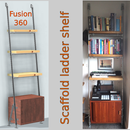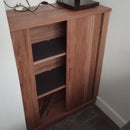Introduction: Wooden Speaker Stands
I have recently moved and instead of wall mounting my satellite speakers I wanted to put them on some stands. I started by looking at some images on the internet and developing my own ideas about what I wanted. I eventually decided that I wanted a slim stand, made with two main wooden columns with additional different coloured woods spanning between them in the centre with a nice curve to the front, with a top and bottom block made from some of a spalted beach slab I already had. I went to a timber yard just down the road from my new house as I saw on ebay they had some hardwoods in stock. I decided to go with Sapele as I wanted something fairly dark and I had never used it before. I also used a section of oak I had left over from a previous project.
Material list
Sapele wood 4No. 950mm x 100mm x 19mm (37.5" x 4" x 3/4")
Oak wood 2No. 650mm x100m x 19mm (25.5" x 4" x 3/4")
Spalted beach wood 2No. 170mm x 150mm x 38mm (6.5 x 6" x 1.5")
2No. 200mm x 200mm x 38mm (8" x 8" x 1.5")
Wood glue
6mm * 20mm Nut inserts
300mm x 6mm Threaded bar
Tool list
Table saw
Band saw
Router
Chisels
Hand saw
Step 1: Process Wood
The first step is to process the wood to flatten the wood. I used my planer/thickness to fist plane (joint) the sapele, it wasn't too bent/twisted so it didn't take too long to get the first face flat. Once that face was flat I switched to thicknessing mode with the flat planned face on the in-feed table, so both faces were flat and parallel.
I cut the spalted beach for the base and top and went through the same process as for the sapele. The oak I used was an offcut and already flat so this didn't need anything extra doing to it.
I then cut all the parts to rough sizes.
Step 2: Shaping the Uprights
I wanted a curve to the front of the stand uprights so to get a smooth curved I grabbed a piece of thin oak I had lying around and clamped some small bits of wood to either end and clamped the thin wood to them. I then adjusted the angle of the small pieces at each end until the curve looked about right. I then drew the curve on with a pencil and cut it out with a bandsaw. I then followed this with a small amount of smoothing with a card scraper.
Once I had the first upright done I traced the pattern on the remaining uprights and cut the waste out (just outside the trace line) with the bandsaw. I did the same with the oak pieces.
To get them all to the correct size I used double sized tape (double stick tape) to fix the main upright to one that need trimming and used a pattern bit on my router table.
Step 3: Tenons
I decided to use some real joinery to fix the uprights to the base and top so made some tenons on the top and bottom of each of the four uprights. I used the table router to do this using the fence for reference. I started off with the router bit low and raised it bit by bit (cutting both sides) and testing the joint in a grove i had cut on an offcut bit of wood.
Step 4: Gluing Up, Final Shaping and Sanding
Once all the bits were the right size and the tenons cut i sanded the insides of the uprights I wouldn't easily get to once they were glued together. I then glued the upright pieces together and waited for a few hours for them to dry.
I then used an oscillating bobbin sander, card scraper and sander to finish the uprights. I sanded up to 320 grit for a super smooth finish.
Step 5: Mortises
Now the uprights were finished I could measure the unclamped distance between the tenons to set out the mortises precisely. I then used my palm router to cut the mortises using a piece of wood as a guide. I then squared off the ends of the mortises with a chisel.
Step 6: Clamping and Finishing
I then did a dry fit test to make sure all the joints were a good fit followed by gluing the joints and clamping between the base and tops. I then put on three coats of danish oil rubbing down with steel wool between coats.
Step 7: Spikes
These stands were going to be placed on carpet so I wanted to add some spikes to the base of the stands.
I drilled four 6mm holes to each base and screwed in the insert nuts with an allen key.
To make the spikes I used a bench grinder to create a spike on the end of some threaded rod. Once I was happy with the spike I cut off the length I wanted with a cut-off disk on a dremmel and put them in to the insert nuts.
Step 8: Finished
Overall I was very happy with my new stands......my speakers were above the height of the sofa and they looked good! Having never used sapele wood before I was happy with the way it worked in the planed and how well it finished with fairly little effort. I will definitely be using it again on another project!

Participated in the
Furniture Contest 2017

Participated in the
Audio Contest 2017











